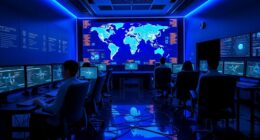ID.me prioritizes security with 256-bit encryption, limited data access, and regular audits to fend off hackers effectively. By employing strong firewalls and constant system monitoring, they fortify defenses against cyber threats. Their deletion of unnecessary data mitigates risks and showcases a commitment to user data protection. With multifactor authentication, stringent access controls, and industry best practices, ID.me upholds robust security standards. Incident monitoring, prompt responses, and data encryption further bolster their safeguarding efforts. While risks exist, ID.me's proactive security measures and transparency address concerns. Learn more about their thorough security approach by exploring their detailed protocols and incident response strategies.
Key Takeaways
- Utilizes 256-bit encryption for secure data transmission.
- Implements strong firewalls and 24/7 system monitoring.
- Limits employee access and undergoes third-party security audits.
- Deletes unnecessary data and maintains access controls.
- Demonstrates commitment to safeguarding user data.
Overview of ID.me Security Measures
The security measures implemented by ID.me serve to safeguard user information from potential hackers with robust encryption and stringent access controls. Utilizing 256-bit encryption, ID.me guarantees that data is securely transmitted and stored, making it highly challenging for hackers to intercept or decipher sensitive information.
Additionally, the platform limits employee access to data, undergoes regular third-party security audits, and maintains strong firewalls while monitoring the system 24/7 to prevent unauthorized access attempts.
By deleting unnecessary data, ID.me minimizes risks and enhances the protection of user information against potential hacking threats. These bank-level security measures not only demonstrate ID.me's commitment to safeguarding user data but also make it a reliable choice for individuals seeking a secure platform to interact with.
With a thorough approach to security, ID.me establishes itself as a trustworthy service provider dedicated to protecting user data from hackers.
Encryption and Data Protection

Utilizing advanced encryption protocols, ID.me fortifies its data protection framework against potential security breaches by hackers. The platform employs 256-bit encryption to secure personal information, making it highly difficult for hackers to intercept and misuse user data.
In addition to encryption, ID.me implements stringent security measures to safeguard against unauthorized access and data breaches. Employee access to sensitive data is restricted, reducing the risk of internal security threats. Regular third-party security audits are conducted to assess and enhance data protection measures.
Continuous 24/7 monitoring is in place to detect and prevent security breaches promptly. Data that is no longer necessary is promptly deleted to minimize the risk of exposure to hackers. Robust security tools like firewalls complement encryption to fortify the defense against potential hacking attempts.
Access Management Controls

ID.me incorporates a sophisticated role-based access management system to regulate user permissions effectively.
By implementing multifactor authentication, the platform strengthens security measures to thwart unauthorized logins.
Additionally, regular security audits are conducted to guarantee compliance with information security regulations and maintain data integrity.
User Permissions
Effective user permissions management plays a critical role in safeguarding data and resources within the ID.me system. By employing role-based access management, ID.me guarantees that users are only granted permissions necessary for their specific job functions. This practice greatly reduces the risk of unauthorized access and enhances overall system security.
Access controls within the system are enforced through multifactor authentication, requiring users to provide multiple forms of verification to access sensitive data or systems. ID.me adheres to industry best practices for user permissions, strictly limiting access to authorized personnel only.
Regular reviews and updates of user access permissions are conducted to ensure that they align with current job roles and responsibilities, further enhancing the security measures in place. This meticulous approach to user permissions underscores ID.me's commitment to maintaining a secure environment for its users and their data.
Authentication Methods
To guarantee robust security measures, ID.me employs stringent authentication methods as part of its access management controls.
The use of multi-factor authentication enhances account security by requiring users to provide multiple forms of verification before accessing their accounts, reducing the risk of unauthorized access by hackers.
ID.me's security team makes sure that access management controls are in place to restrict employee access to sensitive data, mitigating the potential for insider threats.
Additionally, strong encryption methods like AES-256 are utilized to safeguard user data from malicious actors seeking to compromise the platform's security.
Continuous monitoring and regular security audits are conducted to detect and prevent any unauthorized access attempts promptly.
In addition, user consent and authorization are mandatory for any data release, reinforcing privacy and security measures against hackers.
The combination of these authentication methods underscores ID.me's commitment to maintaining a safe and secure environment for its users.
Audit Trail Tracking
Consistently monitoring and recording user access and activities within the system, audit trail tracking plays a pivotal role in enhancing access management controls at ID.me. This feature helps detect any unauthorized or suspicious behavior by tracking user interactions, thereby enhancing security measures.
By providing visibility into user actions, audit trail tracking aids in preventing and responding to potential security breaches effectively. Moreover, ID.me's implementation of audit trail tracking ensures accountability and transparency in user access and activity, further strengthening overall security protocols.
Through maintaining detailed logs of user interactions, ID.me can investigate and mitigate security incidents promptly.
- Audit trail tracking monitors and records user access and activities.
- Helps detect unauthorized or suspicious behavior by tracking user interactions.
- Enhances security by providing visibility into user actions.
- Ensures accountability and transparency in user access and activity.
- Enables effective investigation and mitigation of security incidents.
Multifactor Authentication Implementation

The implementation of multifactor authentication in ID.me's security framework greatly enhances user account protection against unauthorized access and potential hacking incidents. Multifactor authentication requires users to provide two or more forms of verification, such as a password, SMS code, or biometric data, before gaining access to their accounts. This additional layer of security greatly reduces the risk of unauthorized access and minimizes the chances of hacking attempts succeeding.
| Benefits of Multifactor Authentication |
|---|
| Enhances Account Security |
| Mitigates Unauthorized Access |
| Reduces Hacking Attempts |
| Aligns with Cybersecurity Best Practices |
| Strengthens Defense Mechanisms |
Users have the option to enable multifactor authentication in their ID.me account settings, ensuring that only authorized individuals can access their accounts. By combining what users know (password) with what they have (SMS code), ID.me fortifies its defenses against potential hacking threats. This approach aligns with industry best practices for cybersecurity, safeguarding user accounts and sensitive information effectively.
Third-Party Security Audits

ID.me places a strong emphasis on external audits conducted by third-party security firms. These audits play an essential role in validating the effectiveness of ID.me's security measures, ensuring compliance with industry standards and best practices.
External Audit Importance
Undergoing regular third-party security audits, ID.me prioritizes external validation of its data protection and security measures.
- External audits help identify vulnerabilities and areas for improvement in ID.me's security measures.
- Third-party audits provide independent validation of ID.me's data protection and security controls.
- These audits help boost confidence in the platform's security by demonstrating adherence to rigorous security standards.
- ID.me's commitment to external audits showcases a proactive approach to maintaining a secure environment for user data.
- By subjecting itself to external scrutiny through third-party security audits, ID.me demonstrates a commitment to transparency and accountability in safeguarding user information.
Audit Frequency Benefits
Regular third-party security audits play an essential role in enhancing the overall cybersecurity posture of organizations like ID.me. By undergoing these audits at regular intervals, ID.me can guarantee compliance with industry standards and best practices, ultimately safeguarding user data against potential cyber threats.
These audits serve as proactive measures to identify and address vulnerabilities or weaknesses in ID.me's security measures, allowing for timely remediation actions. The frequency of these audits not only demonstrates ID.me's dedication to maintaining a high level of security but also signifies a commitment to continuous improvement in response to evolving cybersecurity challenges.
Through third-party assessments, ID.me receives an objective evaluation of its security controls, contributing to building trust and confidence in the platform. By prioritizing the regularity of security audits, ID.me can stay ahead of potential threats, strengthen its security posture, and uphold its commitment to protecting user information effectively.
Incident Monitoring and Response

Incident monitoring and response at ID.me are essential elements of their comprehensive security strategy to safeguard user information and prevent unauthorized access by hackers.
Regular 24/7 platform monitoring guarantees immediate detection of any suspicious activities.
Third-party security audits are conducted periodically to maintain compliance with industry standards.
Incident response protocols are in place to address security issues promptly and effectively.
Security measures such as data encryption and firewalls are implemented to protect user data from potential breaches.
ID.me's dedicated security team, equipped with certifications in privacy and security program management, plays a crucial role in ensuring the platform's security integrity.
Limited Data Retention Policy

How does ID.me's limited data retention policy contribute to enhancing the platform's security measures against potential cyber threats?
ID.me's approach of implementing a limited data retention policy plays an essential role in mitigating security risks and safeguarding user data. By deleting data that is no longer necessary, ID.me reduces the likelihood of exposure to hackers and minimizes the impact of potential data breaches.
This practice guarantees that only essential user information is retained, lowering the volume of sensitive data that could be targeted by malicious actors. Such stringent data management aligns with industry best practices for data security and privacy, fostering user trust in the platform's commitment to safeguarding sensitive information.
Ultimately, ID.me's limited data retention policy significantly strengthens its overall security posture, enhancing protection against cyber threats and reinforcing the platform's resilience in the face of evolving security challenges.
Risks Associated With Id.Me

ID.me's centralized storage of sensitive personal data poses significant privacy and security risks, making it a prime target for hackers seeking to exploit vulnerabilities.
Limited alternatives for verification may exclude some individuals, potentially increasing the risk of unauthorized access.
The use of facial recognition software by ID.me can be unreliable, opening up vulnerabilities for potential exploitation by hackers.
Users relying on ID.me are entrusting their personal information to a third-party company, increasing the risk of data breaches or unauthorized access.
Concerns about the security of ID.me have been raised due to past incidents of poor transparency, communication issues, and instances of fraud and system vulnerabilities.
The integration of facial recognition technology, while intended to enhance security, has raised concerns about the accuracy of identity verification and the potential for breaches in the system.
These risks underscore the importance of robust security measures and vigilance in safeguarding personal data when utilizing ID.me for verification purposes.
Past Security Incidents

In light of historical events that have raised concerns about security and transparency, ID.me has faced notable incidents reflecting vulnerabilities in its verification systems and processes.
Users of ID.me have encountered security issues, with instances in 2021 where facial recognition technology blocked access to benefits, and a user managed to deceive the system using a simple wig, exposing flaws in the software.
The CEO of ID.me came under scrutiny for alleged mishandling of Covid relief funds, contributing to doubts about the platform's integrity.
Additionally, the Internal Revenue Service (IRS) ceased its utilization of ID.me due to inaccuracies in the verification services provided, indicating a lack of reliability in the identity verification process.
These incidents highlight the importance of ensuring robust security measures and transparency when handling sensitive information online, especially when it pertains to verifying the identities of users through platforms like ID.me.
Frequently Asked Questions
Is It Safe to Give Id.Me My Social Security Number?
Providing your social security number to ID.me is safe due to robust security measures. The platform employs bank-level encryption, undergoes regular audits, and limits employee access. Users have control over their data and consent to its release, enhancing security.
Is Id.Me a Trustworthy Site?
In the domain of digital identity verification, ID.me stands as a beacon of trustworthiness. Accredited by the US GSA FICAM, compliant with stringent security frameworks, and fortified by bank-level encryption, ID.me upholds its reputation as a reliable site.
Can Id.Me Get Hacked?
ID.me's robust security measures, compliance with industry standards, encryption of Personally Identifiable Information (PII) with FIPS 140-2 approved algorithms, hosting within FedRAMP authorized AWS, and regular security audits collectively reduce the likelihood of successful hacking attempts.
What Information Does Id.Me Have Access To?
ID.me has access to personal details such as name, address, date of birth, and social security number. It securely stores scanned government-issued IDs, utilizing facial recognition for verification. The platform employs encryption and strict security protocols.
Conclusion
In the domain of cybersecurity, ID.me stands as a fortress against the onslaught of hackers, with its robust encryption, access controls, and multifactor authentication. However, risks still linger, as past incidents have shown vulnerabilities.
Despite this, ID.me remains vigilant, with third-party audits, incident monitoring, and limited data retention policies in place.
As the saying goes, 'A chain is only as strong as its weakest link,' and ID.me continues to fortify its defenses to protect user information from cyber threats.









